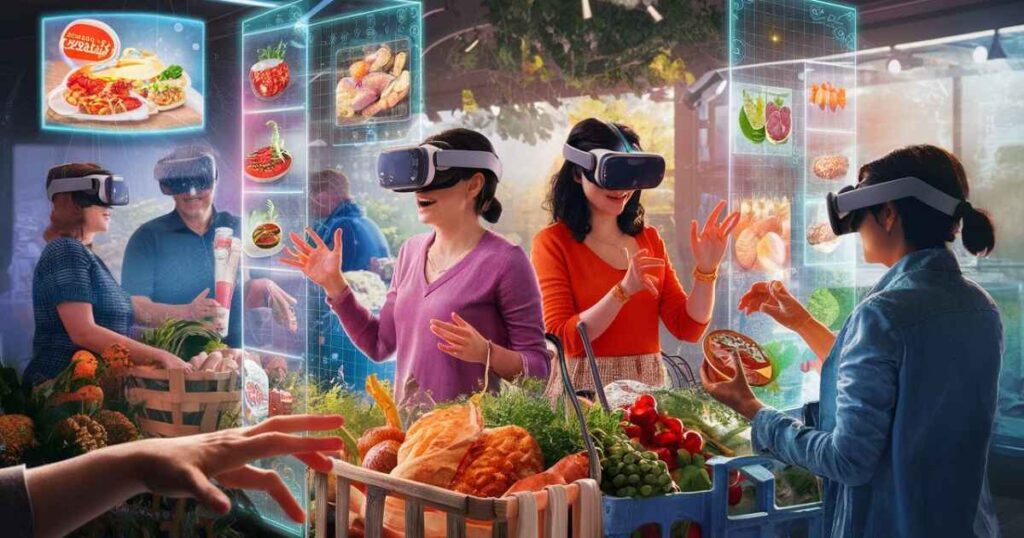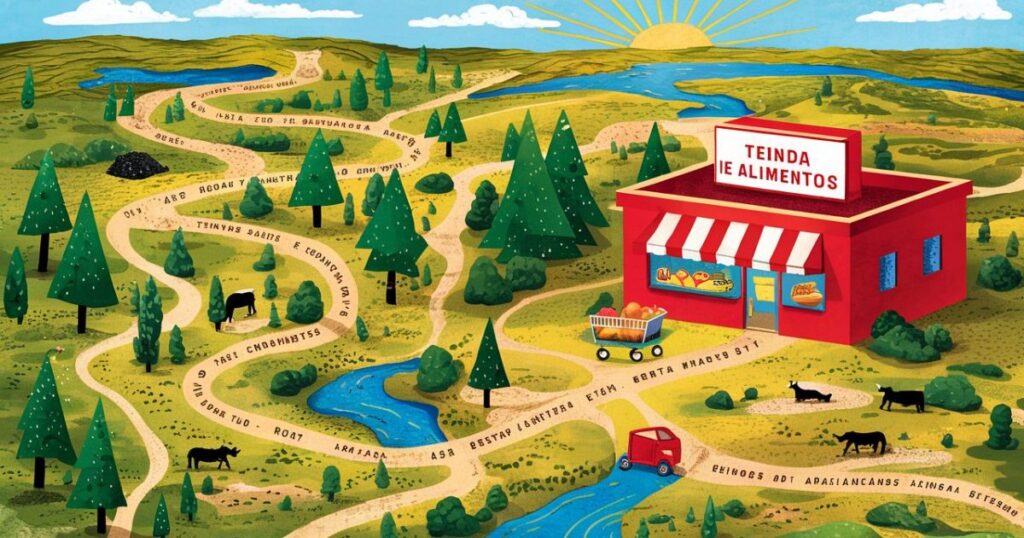In our fast-paced modern lives, the ability to effortlessly navigate and locate nearby amenities is invaluable. This is especially true when it comes to something as essential as grocery shopping. The phrase “Indícame el camino a la tienda de alimentos más cercana” (Spanish for “Show me the way to the nearest food store”) has become a common request, reflecting the growing reliance on technology to guide us to our destinations. This comprehensive guide will explore the world of navigation apps, food-specific tools, and the art of discovering local culinary gems.
Overview on Navigation
Navigation tools have come a long way from the days of unfurling physical maps and tracing routes with our fingers. Today, we have powerful digital assistants at our fingertips, courtesy of smartphones and innovative apps. These apps not only provide turn-by-turn directions but also incorporate real-time traffic updates, voice guidance, and even augmented reality features to make our journeys smoother and more efficient.
The Role of GPS and Mapping Services
At the heart of modern navigation lies the Global Positioning System (GPS), a network of satellites that precisely pinpoint our locations. Combined with detailed mapping data, GPS enables apps like Google Maps, Apple Maps, and Waze to chart the most optimal routes to our desired destinations. These apps have become indispensable tools, offering features such as:
- Voice-guided navigation
- Live traffic updates and rerouting
- Estimated time of arrival calculations
- Lane guidance for complex intersections
- Offline map accessibility for areas with poor connectivity
The seamless integration of GPS and mapping services has revolutionized the way we navigate, making it easier than ever to find our way, whether in familiar surroundings or new territories.
Food Apps and Navigation
While general navigation apps are incredibly useful, there’s a growing demand for specialized tools tailored to our culinary needs. Food-specific apps like Yelp, Zomato, and Foursquare have become popular resources, combining mapping capabilities with extensive databases of restaurants, grocery stores, and other food-related establishments.
These apps often offer advanced search filters, allowing users to find options based on specific dietary preferences (e.g., vegan, gluten-free), cuisine types, price ranges, and even user ratings. By integrating mapping and food data, these apps streamline the process of discovering new dining experiences or locating the perfect grocery store to suit our needs.
Mobile Apps for an Enhanced Shopping Experience
In addition to navigation and discovery, mobile apps are transforming the grocery shopping experience itself. Many major supermarket chains now offer dedicated apps that cater to the modern shopper’s needs. These apps often include features such as:
- Digital grocery lists and shopping cart functionality
- In-store navigation and aisle guidance
- Coupon clipping and loyalty program integration
- Online ordering and curbside pickup options
- Augmented reality (AR) tools for locating specific products
By leveraging these apps, consumers can plan their shopping trips more efficiently, save time in the aisles, and even minimize physical contact during the checkout process – a particularly valuable feature in the wake of the COVID-19 pandemic.
Advantages of Food Apps and Navigation
The combination of food-specific apps and navigation tools offers numerous advantages to consumers, including:
- Time-saving: By quickly locating the nearest grocery store or restaurant, users can minimize travel time and make more efficient use of their day.
- Dietary accommodations: Apps often allow users to filter options based on specific dietary needs or preferences, such as vegan, gluten-free, or kosher options.
- User reviews: Many food apps incorporate user reviews and ratings, providing valuable insights into the quality of establishments before visiting.
- Discover new options: These apps expose users to a wider range of dining and shopping options, encouraging exploration beyond familiar haunts.
- Maximize savings: Features like digital coupons, loyalty program integration, and pricing comparisons can help users maximize their grocery budgets.
Searching for food has become very easy
Thanks to the proliferation of mobile apps and the integration of mapping technologies, finding nearby food options has never been easier. With just a few taps on our smartphones, we can instantly see a comprehensive list of grocery stores, restaurants, and other food-related establishments in our vicinity.
For example, a simple search on Google Maps for “grocery stores near me” will populate a map with various options, complete with pertinent information such as business hours, ratings, and even photos. This level of convenience has streamlined the process of grocery shopping, allowing us to make informed decisions and plan our trips more efficiently.
Related Post: What Kind of Laptop Does UMA Give Students?
Changes in experience of food shopping

Mobile apps and navigation tools have fundamentally transformed the grocery shopping experience. Gone are the days of aimlessly wandering through unfamiliar neighborhoods in search of a suitable store. Instead, we can now leverage technology to:
- Plan our routes: Apps like Google Maps and Waze can chart the most optimal routes to our desired grocery store, taking into account factors like traffic conditions and road closures.
- Discover new options: Food-specific apps expose us to a wider range of grocery stores, including local markets and specialty stores we may have previously overlooked.
- Enhance in-store experience: Once inside the store, dedicated grocery apps can guide us through the aisles, help locate specific items, and even facilitate contactless checkout processes.
- Stay informed: These apps often provide valuable information about store hours, sales, and promotions, allowing us to plan our shopping trips accordingly.
The convenience and efficiency afforded by these technological advancements have undoubtedly transformed the once-mundane task of grocery shopping into a more streamlined and enjoyable experience.
Some challenges of using food Apps and Navigation
While the benefits of food apps and navigation tools are numerous, it’s important to acknowledge some potential challenges and drawbacks:
- Data privacy concerns: Many users express concerns about the amount of personal data collected by these apps, including location information and browsing habits.
- Outdated or inaccurate information: Relying solely on app data without verifying can lead to frustrating situations, such as encountering closed businesses or incorrect store hours.
- Over-reliance on technology: There’s a risk of becoming too dependent on these tools, potentially diminishing our ability to navigate and explore without technological assistance.
- Accessibility issues: Not all users may have access to smartphones or reliable internet connections, limiting the usefulness of these apps in certain areas or communities.
It’s crucial to strike a balance between leveraging the convenience of these tools and maintaining a level of human knowledge and adaptability when it comes to navigating and exploring our surroundings.
Engaging with Locals for Insider Tips
While technology can provide a wealth of information, there’s no substitute for the invaluable insights and recommendations of local residents. Engaging with locals can often lead to the discovery of hidden gem grocery stores and markets that may not be prominently featured on mainstream apps.
Local residents are intimately familiar with the culinary landscape of their neighborhoods, and their recommendations can offer a unique perspective on the best places to shop for specific ingredients, cultural delicacies, or simply the freshest produce. Furthermore, building connections with locals can foster a sense of community and provide a deeper appreciation for the cultural diversity that often manifests itself through food.
Exploring Neighborhood Options
While major chain grocery stores offer convenience and familiarity, there’s a certain charm and authenticity to be found in exploring neighborhood options. Local markets and specialty stores often provide a more intimate shopping experience, offering unique products and a glimpse into the cultural fabric of the community.
By venturing beyond the familiar big-box stores, shoppers can discover a world of culinary delights, from artisanal bakeries and butcher shops to ethnic markets and family-owned produce stands. These establishments not only offer a diverse array of products but also serve as cultural hubs, where traditions and flavors are celebrated and shared.
The Convenience of Chain Stores vs. The Charm of Local Markets
When it comes to grocery shopping, there’s no one-size-fits-all solution. Both chain stores and local markets offer their own unique advantages and drawbacks:
Chain Stores:
- Pros: Consistent product availability, predictable layouts, convenient locations, competitive pricing.
- Cons: Limited selection of niche or specialty items, lack of personalized service, potential impact on local businesses.
Local Markets:
- Pros: Diverse and unique product offerings, personalized service, supporting local economies, connection to cultural traditions.
- Cons: Potentially higher prices, limited parking, inconsistent hours/availability, unfamiliar layouts.
The key is to strike a balance and embrace the best of both worlds. Chain stores can provide a reliable baseline for routine shopping, while local markets offer opportunities for exploration, culinary adventures, and supporting the local community.
Adapting Shopping Strategies in Response to Changing Dynamics
The COVID-19 pandemic has significantly impacted our grocery shopping habits, accelerating the adoption of various technological solutions. As concerns over public health and safety grew, many consumers turned to online ordering and curbside pickup options to minimize physical contact.
Grocery delivery services, once a niche convenience, became a lifeline for many households during lockdowns and stay-at-home orders. Apps like Instacart and Amazon Fresh saw a surge in demand, enabling users to have their groceries delivered to their doorsteps with minimal risk of exposure.
However, even as restrictions ease, these new shopping behaviors are likely to persist. Consumers have grown accustomed to the convenience of online ordering and contactless pickup, and many grocery stores have invested heavily in infrastructure to support these services.
Moving forward, successful grocery shopping strategies will involve a blend of traditional in-store visits and leveraging technology for efficiency and safety. Apps that offer features like in-store navigation, digital shopping lists, and contactless checkout will continue to play a crucial role in enhancing the overall shopping experience.
Indícame el camino a la tienda de alimentos más cercana

The phrase “Indícame el camino a la tienda de alimentos más cercana” (Spanish for “Show me the way to the nearest food store”) highlights the growing importance of catering to diverse communities and language preferences.
As the Hispanic/Latino population in the United States continues to grow, the demand for multilingual navigation and food-related services has increased. Apps that offer language support and localized search capabilities can better serve these communities, ensuring that language barriers do not hinder access to essential resources like grocery stores.
Furthermore, the integration of language support into navigation apps can foster a more inclusive and welcoming environment for travelers and tourists, enhancing their ability to explore local culinary offerings and navigate unfamiliar surroundings with ease.
FAQs about Indícame el camino a la tienda de alimentos más cercana
- How do I ensure I’m getting the most accurate results for nearby grocery stores?
- Make sure your location services are enabled and providing accurate data.
- Cross-reference results from multiple apps or sources to verify information.
- Check business hours and updates to avoid visiting closed establishments.
- Can I search for specific types of grocery stores (e.g., organic, ethnic markets)?
- Most apps offer advanced search filters or categories to narrow down your options based on preferences.
- Look for keywords or tags like “organic,” “ethnic,” “halal,” etc.
- What should I do if I encounter incorrect or outdated information on an app?
- Report the issue to the app developers, as this feedback helps improve the data.
- Leave reviews or ratings to warn others about inaccuracies.
- As a last resort, call the establishment to verify information before visiting.
- How can I optimize my route to multiple grocery stores?
- Many apps offer route optimization features that can plan the most efficient multi-stop trips.
- Prioritize your stops based on urgency or proximity to minimize backtracking.
- Are there any privacy concerns with using location-based food and navigation apps?
- Review the app’s privacy policy to understand data collection practices.
- Adjust location and permission settings to limit data sharing if desired.
- Consider using a virtual private network (VPN) for an added layer of privacy.
Conclusion
In our modern, fast-paced world, the ability to effortlessly locate and navigate to nearby grocery stores and food establishments has become paramount. Thanks to the convergence of mobile technology, GPS, and mapping services, the once-daunting task of finding the nearest store has been transformed into a seamless and convenient experience.
However, this technological revolution is about more than just convenience; it’s about fostering a deeper connection with our local communities and culinary landscapes. By leveraging these tools, we can discover hidden gems, support local businesses, and explore the rich tapestry of cultures and traditions that manifest through food.
As we continue to adapt to changing dynamics, such as the lasting impacts of the COVID-19 pandemic, our shopping strategies will likely evolve, incorporating a blend of in-person visits and technological solutions like online ordering and contactless pickup.
FAQ’s
¿Dónde se compra el alimento?
Los alimentos se compran en varios lugares, como supermercados, mercados de agricultores y tiendas especializadas, ofreciendo una amplia gama de opciones a los consumidores.
¿Cómo llegan los alimentos a nuestra comunidad?
Los alimentos llegan a nuestra comunidad a través de una compleja red de canales de distribución que involucran el transporte en camiones, trenes, barcos y, a veces, aviones, conectando a los productores con los mercados y minoristas locales.
¿Dónde se adquirieron los alimentos?
Los alimentos se adquieren de multitud de fuentes, incluidas tiendas de comestibles, agricultores locales, plataformas en línea y programas agrícolas apoyados por la comunidad, que atienden a diferentes preferencias y necesidades.
¿Dónde salen los alimentos?
Los alimentos se originan en granjas, instalaciones de procesamiento y centros de distribución, donde se preparan, empaquetan y envían a varios puntos de venta, garantizando disponibilidad y accesibilidad para los consumidores.







